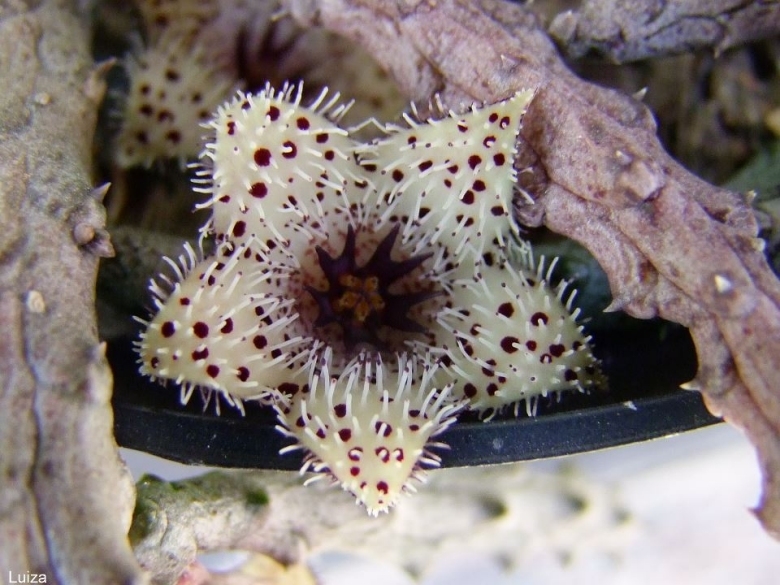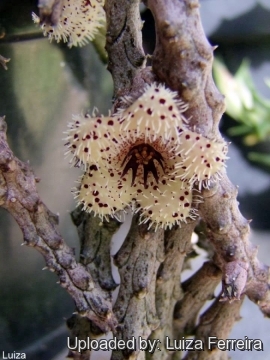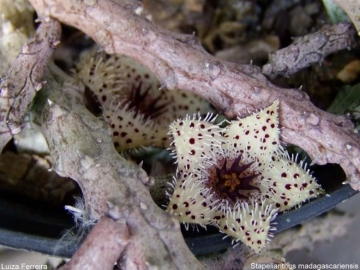




Your support is critical to our success.
Stapelieae (White & Sloane) ed. 1 71 1933
Family: ASCLEPIADACEAE

Origin and Habitat: Stapelianthus madagascariens is is only known from south western Madagascar with a known distribution extending northwards to St. Augustin near Toliara.
Habitat and ecology: This species grows in xerophytic bush.
Synonyms:
- Stapelianthus madagascariensis (Choux) Choux ex A.C.White
Description: Stapelianthus madagascariensisSN|30460]]SN|30460]] is a low running succulent with very mottled stems that can form large compact clumps and produce small cream-coloured, bell-like, flowers with red spots and white spiny papillae, these are produced in clusters near the stem-bases.
Stems: Procumbent to ascending, 6-8 mm thick, rooting at base, leaf tubercles (podaria) in 5-6 spirals, with tiny apical, greyish-green to, brownish dark-red mottled apex with small, acute-triangular, deciduous non-spiny leaflet.
Flowers: Solitary or in few-flowered inflorescence near the stem-base. Corolla broadly campanulate, c. 2 mm across, with a short tube, throat 5 deep, 7 mm wide, with broadly triangular spreading lobes, 7-8 mm, white or yellowish, with dull purple blotches and long white papillae 2-3 mm long, apex red. Outer corona c. 3.5 mm across, black-purple.
Fruits: Flies pollinated, the flowers resulting in the typical twin seed horns (follicles), which are decorative in themselves and often don't appear until a year later.
Blooming time: Flowers are freely produced throughout the late summer and autumn.
Notes: Stapelianthus madagascariensisSN|19215]]SN|30460]] forms a complex with Stapelianthus hardii and Stapelianthus montagnaciiSN|30460]]SN|19215]], all three species being found only in the south west of Madagascar.
Bibliography: Major references and further lectures
1) Edgar Lamb. “Stapeliads in Cultivation” Blandford Press, 1957
2) Werner Rauh, Herman Schwartz “Succulent and xerophytic plants of Madagascar” Volume 2 Strawberry Press, 1998
3) White & Sloane. “The Stapelieae” edn 2. Abbey San Encino Press, 1937
4) James Cullen, Sabina G. Knees, H. Suzanne Cubey “The European Garden Flora Flowering Plants: A Manual for the Identification of Plants Cultivated in Europe, Both Out-of-Doors and Under Glass” Cambridge University Press, 11/August /2011
5) Focke Albers, Ulrich Meve “Illustrated Handbook of Succulent Plants: Asclepiadaceae” Volume 5 Springer, 2002

Stapelianthus madagascariensis Photo by: Luiza Ferreira

Stapelianthus madagascariensis Photo by: Luiza Ferreira
Cultivation and Propagation: Stapelianthus madagascariensisSN|17851]]SN|30460]] is a xerophytic plant adapted to dry soils, but despite its provenance it is without doubt an easy species to grow and not difficult as commonly supposed only bearing in mind that this species benefits from slightly warmer winter than others.
Growth rate: It is a relatively rapidly growing and easily flowering species that will make large clumps given the best conditions. Most plants will offset readily, and clumps can be produced in a few years.
Soils: It likes very porous mineral cactus mix soil, pH 7,5 to 8,5 (mildly alkaline), but can become too elongated if compost is too rich.
Repotting: This plant needs plenty of space for its roots, repotting should be done every other year or when the it has outgrown its pot. Use pot with good drainage.
Watering: It needs regular watering, especially during the hottest summer days; provide also some light watering if the green house temperatures in winter are elevated. Either excessive or very scarce watering can induce rot.
Fertilization: Feed with a high potassium fertilizer in summer.
Frost Tolerance: For safe cultivation it is best to avoid freezing temperatures (minimum 5° C). In the rest period no high atmospheric humidity!!
Sun Exposure: Best for half-shade but grow well in full sun and full shade too. Tends to bronze in strong light, which encourages flowering, but is likely to suffer from sun scorch or stunted growth if over exposed to direct sunlight during the hottest part of the day in summer.
Diseases: This species is relatively resistant to cryptogamic diseases than others and is quite resistant to the “Balck spot” disease of Asclepiads. Rot it is only a minor problem with Stapelianthus decaryiSN|30460]]SN|17851]] if the plants are watered and “aired” correctly. If they are not, fungicides won't help all that much.
Uses: It is an excellent plant for container growing. Cascading, clustering, great for a hanging display. Stems may possibly become purple and limp in winter, but revitalize in early spring. It always looks good and stays small. It look fine in a cold greenhouse and frame or outdoor in a rockery.
Propagation: Seeds and cuttings. Cuttings will root only in hot weather. Cuttings must be kept very dry to root. Seeds germinate readily if they are sown when fresh.
| Your Actions | |
|---|---|
| Back to Stapelianthus index | |
| Back to Asclepiadaceae index | |
 |
Back to Succulents Encyclopedia index |
Privacy stantement - Terms and conditions - How to cite - About us - Feedback - Donate



